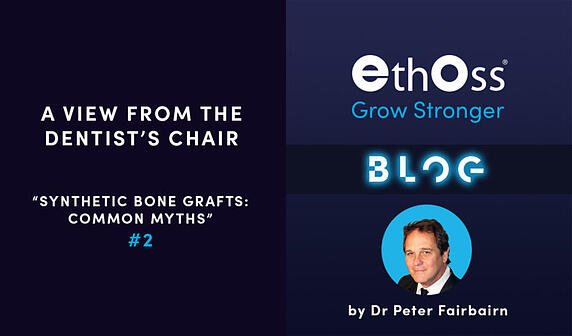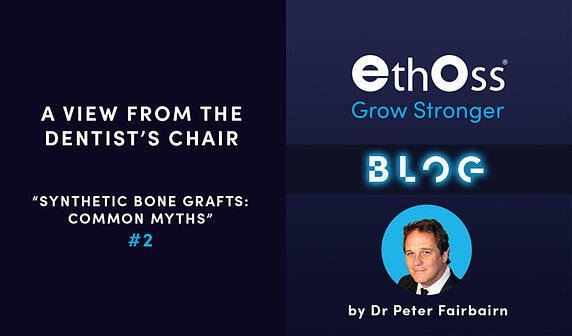SYNTHETIC BONE GRAFTS: COMMON MYTHS 2

Welcome to the second installment of "Synthetic Bone Grafts: Common Myths" by Dr Peter Fairbairn from EthOss.
This article addresses the common belief that a collagen membrane is always needed for grafting - with Dr Fairbairn making a compelling argument to dispel this myth.
Read on to find out why...

“Without a collagen membrane you will get soft tissue ingress”
It is important to start this blog with a distinction. At no point am I saying that soft tissue ingress is a myth – it is a problem that dentists all over the world have faced when using foreign grafts (xenografts, allografts) and it is traditionally countered through the use of a collagen membrane.
The myth is that it is impossible to graft without using a collagen membrane. EthOss has proven to dentists all over the world that this is fundamentally untrue, however, it is still the most common question I get asked when lecturing in a country for the first time.
So why do dentists use collagen membranes? The textbook reason is twofold:
1) To prevent soft tissue ingress
2) Stability
“Soft tissue ingress” is the key term here.
I have read a lot of research over the years but the area of soft tissue ingress doesn’t seem to have been that widely investigated. This has led many people to believe it is “automatic” and that fibrous tissue will automatically grow into a graft site without any protection.
To my knowledge, this is not the whole story. Soft tissue ingress can be caused by three separate problems:
1) Micro-movements in the graft material. Research has shown that micro-movements can cause the mesenchymal stem cells to differentiate from osteoblasts to fibroblasts, leading to fibrous tissue growth rather than hard tissue.
2) Giant cell reaction to foreign particles. This is particularly an issue with xenografts which the host identifies as a foreign body, leading to a giant cell reaction which encapsulates the foreign particles in fibrous tissue.
3) Degranulation tissue. It is vital that all bone defects are thoroughly cleaned of degranulation tissue before grafting.
Let’s take a closer look…
Point three is probably the most common and is not the fault of the graft material. Unfortunately, this is one of those areas where we need to look at our own cleaning techniques and instruments. People often use EthOss Degranulation burs to help with this process.
Points one and two can be avoided through clever material design. By using a biocompatible material (such as EthOss – BTCP and CS) you are removing the risk of the host foreign body reaction. The action of Calcium Sulphate “setting” in situ reduces micro-movements and increases the inherent stability of the graft.
Removing the collagen membrane is not just a practical or cost benefit – it brings real healing benefits as well. By removing the collagen membrane, we are able to optimise the benefits of the periosteum, placing the graft in intimate contact with the periosteum (and the related blood supply) from day one.
The periosteum is responsible for the most important BMP in bone regeneration, stromal cell-derived factors, which lead to the presence of mesenchymal stem cells in the healing site. This seems to be a key factor in why EthOss works so quickly, generating 50% new bone in as little as 12 weeks.
This is why we describe EthOss as having an integrated “pseudo-membrane”, removing the need for a separate collagen membrane – quite the marvel – but yet it’s a reality! The material has a series of features built-in which replace the traditional membrane, while still performing the same clinical role. Perhaps the biggest benefit here is what it does for your patients. It removes any religious or ethical objections they may have to the porcine content of a typical collagen membrane, while potentially accelerating new bone formation by giving the periosteum direct access to the graft straight away.
So do you always need to use a membrane? Absolutely. Do you always need to use a collagen membrane? No – clever material design and “pseudo-membranes” can replace them and bring a host of extra benefits along the way for you and your patients.